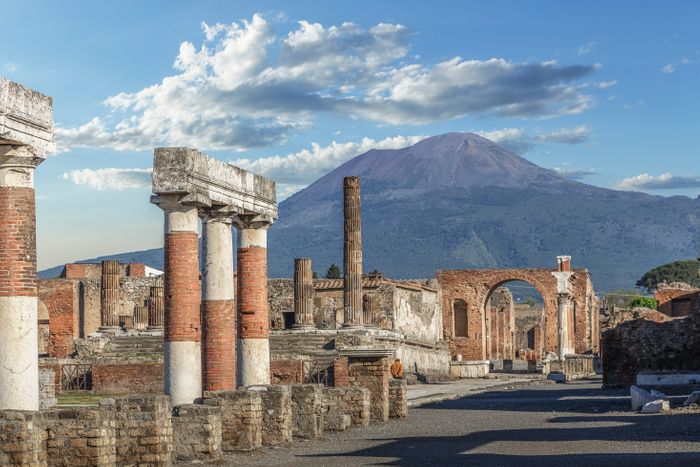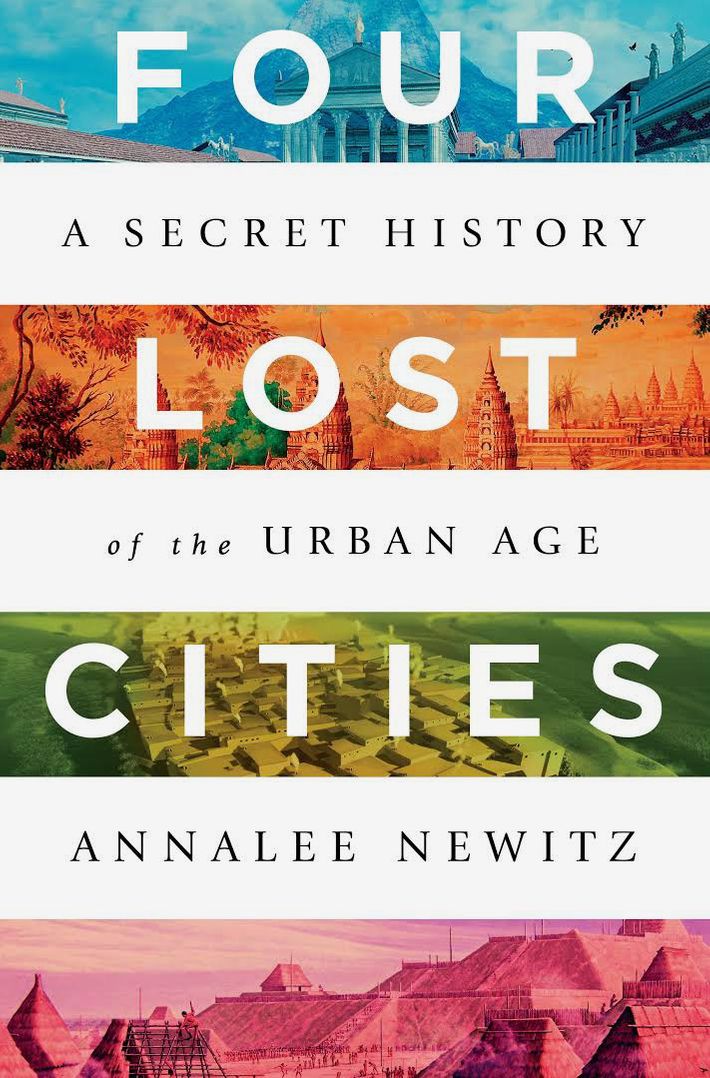
How does a great city die? How does a place that generations saw as a vibrant center — essential, teeming, terrifying, grand — become a sad and silent field? I’ve always found the relics of mass abandonment creepily thrilling: Mayan pyramids pushing through the jungle canopy at Calakmul in Mexico’s Yucatán Peninsula, raucous with monkeys; the ochre-and-gold remains of Morgantina, a gracious Greek enclave high in the Sicilian hills; Bodie, California, once the home of 10,000 miners and scroungers and now just vacant houses and taverns parching in the desert sun. These sites make it easy to envision the future obliteration of Washington, D.C., or Los Angeles. It’s harder to grasp how that passage unfolds, except, perhaps, in the form of some violent upheaval — an earthquake, a pestilence, an alien invasion, burning everything in a matter of minutes.
And yet, as Annalee Newitz writes in a new book, Four Lost Cities: A Secret History of the Urban Age (W.W. Norton), convulsive destruction is rare, and even more rarely definitive. Cities tend to scrabble back from disaster and attain even greater glory, as London did after the Great Fire of 1666, Chicago after its 1871 conflagration, San Francisco after the earthquake of 1906, and Berlin after the Allied bombings of World War II. In his 2005 book, Collapse, Jared Diamond argued that urban death results from the interaction of environmental calamity and war or social upheaval, which periodically overwhelms apparently solid societies, driving them to extinction. Newitz offers a less deterministic and more nuanced overflight of history, alighting on four metropolitan centers that took centuries to rise and endured for centuries more before following unpredictable paths to disarray. No unified theory of failure here.
The cities Newitz examines were radically different. Pompeii was a merchant metropolis, its streets lined with shops, its population organized into providers of specialty services like sex, cooked food, and legal advice. A New Yorker would feel at home there in minutes. The Neolithic city of Çatalhöyük, in what today is Turkey, was a collection of farming villages in which everyone’s home was a workplace. Cahokia, on the banks of the Mississippi, served as a kind of pre-Columbian Vatican, a center of grandeur and religious order. Angkor, in Cambodia, a royal capital carved out of the jungle, was engineered for spectacle and astrological perfection. Each of these places had its own reason to die, usually at such a glacial pace that no one resident or even a whole generation would have registered the decay. The constant is that they expired when their leaders grew tired of keeping them going or the cost of upkeep wasn’t worth the return. Mismanagement and inertia are more formidable foes than cataclysm, though they administer less dramatic death.
Even for Pompeii, the archetypal example of a city crushed by nature’s rage, the end didn’t come as definitively as hindsight would suggest. It’s true that Vesuvius erupted in A.D. 79 and sent a pyroclastic flow of ash, molten rock, and murderous gases sweeping through the streets, killing more than 1,000 people as they cowered and poisoning the volcano’s fertile slopes. And yet thousands more survived to prosper — not in that spot, but in nearby cities, seeding the entire area with Pompeii’s distinctive mix of cosmopolitanism, mercantilism, liberalism, and social mobility. A generation of liberti, or former slaves, took advantage of the move to shed the stigma of their status and, in some cases, appropriate the wealth of the families they had served. The flood of displaced people challenged the imperial government in Rome to meet their needs and match their resourcefulness, which it did by building new roads, stadiums, neighborhoods, and theaters. Enough people profited from disaster to keep Pompeian culture alive.
The long view suggests that what looks like failure eventually morphs into another form of success. Newitz doesn’t touch on Rome’s slow and agonizing illness as the empire fell apart and the city reverted to a muddy slum. And yet it was reborn, again and again. This week, Rome celebrates 150 years since it was wrested from papal control — or, rather, papal neglect — to become the capital of Italy. In the first two decades after 1871, it leapt from a premodern city, its churches interspersed with pastures, orchards, and floodplains, into a metropolis of industrial Europe. Its population doubled in those 20 years, then doubled again and again (it now stands at about 2.8 million), and its prosperity swelled along with it.
Newitz chronicles archaeologists’ attempts to narrate epochs through the stories of individual people. In Pompeii, we meet Julia Felix, an enterprising landlady and bathhouse operator, and a woman named Murtis, who hung out her shingle as a professional fellatrix. The chapter on Çatalhöyük lingers on the figure of Dido, a woman who, about 10,000 years ago, fell hard enough to break several ribs, an injury that threw off her gait for the remaining decades of her life, leaving the marks of suffering etched in her skeleton. Moving up and down ladders and across the tops of houses that functioned as public space, Dido “strolled between rooftop workshops, goat pens, shade canopies, and small braziers for cooking outdoors.” None of these ancient urbanites, Newitz makes clear, would have had reason to shake their heads and mutter that their hometown was doomed.
By the same token, Newitz could not have known, during the years of researching and writing Four Lost Cities, that it would come out just as pundits were proclaiming a new round of urban extinctions. Perhaps this book would have been timely in almost any decade, especially in New York, which has been suffering a more protracted death than the soprano in a Verdi opera. Deindustrialization started squeezing the life out of it in the 1950s, suburbanization kept up the attack in the 1960s, followed by crime in the ’70s, crack in the ’80s, Disneyfication in the ’90s, 9/11 and financial crisis in the 2000s, and gentrification in the 2010s. Now the pandemic is here to finish the job — or perhaps hand it off to sea-level rise. Ashes to ashes, dust to dust, if the virus don’t get you, the climate must.
New York faces some brutal trials in 2021: budget sinkholes, echoey office buildings, vacant storefronts, devastated businesses, and eviscerated cultural institutions. No smiley-faced boosterism will ease the transition. Even if the freshly vaccinated millions emerge from their lairs in search of a long-deferred good time, if the immigration gates swing open again, and if jobs flow back, recovery may well be rough. But all the journalistic catastrophizing portrays a more profound, epochal failure of the kind that Diamond and Newitz chronicled. Pessimists see New York’s entire raison d’être burning away as the creative class meanders off to cheaper, more spacious pastures, taking their tax contributions with them. The notion that a city’s decline can drag on for hundreds of years, or reverse itself a few centuries later, is not much comfort when you have a single lifetime that you would prefer to spend on the upswing. But then perhaps what we really mean when we say that a city is dying is that it has changed since we were young.
One lesson of Newitz’s book is that decline is a collective choice. Angkor’s reservoirs were oriented in the wrong direction to manage its worsening cycle of floods and droughts, and its rulers gave up on rebuilding them. That’s a precedent that the stewards of New York’s infrastructure may want to study. Another conclusion is that cities are social arrangements, not fixed geographical entities or accumulations of architecture. The successful metropolis endures thanks to its adaptive powers. In our time, the changes in façades, streets, costumes, and habits take place at high enough speed that our Didos and Julia Felixes can watch it happen in real time — or on YouTube. Stock footage of New York in the 1910s, ’30s, ’50s, and ’70s, shows us a city of shades and long-demolished buildings that is at once deeply foreign and utterly familiar. Flexibility is the most effective tool of survival.
"four" - Google News
February 05, 2021 at 04:42AM
https://ift.tt/3cIsefS
If Your City Were Really Dying, You Probably Wouldn’t Know - Curbed
"four" - Google News
https://ift.tt/2ZSDCx7
https://ift.tt/3fdGID3


No comments:
Post a Comment